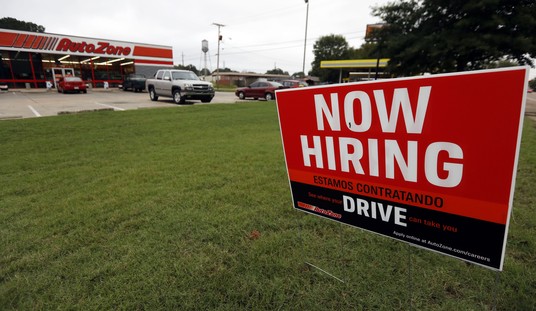Usually, people give too much weight to small changes in the weekly jobless claims rate. Since the spring of 2011, we have seen a range of 360K-380K claims per week, with only occasional outliers, usually within 2-3% of the range. The individual week number is somewhat less meaningful as an indicator than the range, and the trend.
Most of the above doesn’t apply to today’s report, however, as the adjusted number of jobless claims leaped upward by 78,000 to hit 439,000 — the highest level in almost two years:
In the week ending November 10, the advance figure for seasonally adjusted initial claims was 439,000, an increase of 78,000 from the previous week’s revised figure of 361,000. The 4-week moving average was 383,750, an increase of 11,750 from the previous week’s revised average of 372,000.
The advance seasonally adjusted insured unemployment rate was 2.6 percent for the week ending November 3, an increase of 0.1 percentage point from the prior week’s revised rate. The advance number for seasonally adjusted insured unemployment during the week ending November 3 was 3,334,000, an increase of 171,000 from the preceding week’s revised level of 3,163,000. The 4-week moving average was 3,254,500, an increase of 17,750 from the preceding week’s revised average of 3,236,750.
If you’re wondering whether seasonal adjustments might have impacted the report, think again. The seasonal adjustments at this time of year work in the opposite direction; the unadjusted number went up by six figures — 104,548. Also unadjusted, this week had 103,000 more claims than the similar week last year, an increase of almost a third.
Don’t blame Sandy for this, either, at least not entirely [see update]. The states impacted most by the hurricane didn’t make it onto the list of biggest increases, save for New Jersey and Connecticut — but claims there only jumped up by 5,675 and 1,783, respectively and unadjusted. Clearly, these two states aren’t the biggest cause for a jump of 104,000 claims. Both Pennsylvania (7,766) and Ohio (6,450) lost more jobs, thanks to layoffs in manufacturing and other industries.
That didn’t stop the Department of Labor from claiming that the increase came from Hurricane Sandy, though:
Super storm Sandy drove U.S. weekly jobless claims up to 439,000, while consumer prices rose slightly last month as higher rents and costlier food offset cheaper gas.
Sandy drove the number of people seeking unemployment benefits up to a seasonally adjusted 439,000 last week, the highest level in 18 months.
The Labor Department said applications increased by 78,000 because a large number of applications were filed in states damaged by the storm. People can claim unemployment benefits if their workplaces close and they don’t get paid.
If that’s true, their own report doesn’t reflect it. The two most impacted states from Sandy contributed less than 8% of the overall unadjusted increase, which is shown in the table of their own press release. There were more new claims in Pennsylvania alone than in New Jersey and Connecticut combined. New York actually had a decrease in claims (-2,241) due to the storm, thanks to infrastructure that couldn’t rebound in time to process them — but expect those to show up next week.
This could be an anomaly, as any single data point in this series might be. However, it doesn’t bode well for holiday hiring that we had this large bump at the beginning of November, and it might signal a very quiet retail period ahead.
Update: Actually, those numbers at the end are for the previous week’s report (ending 11/3), so Sandy may well be the driver this week. We’ll know more in next week’s report. Do note, though, that the hurricane hit the week before that.








Join the conversation as a VIP Member